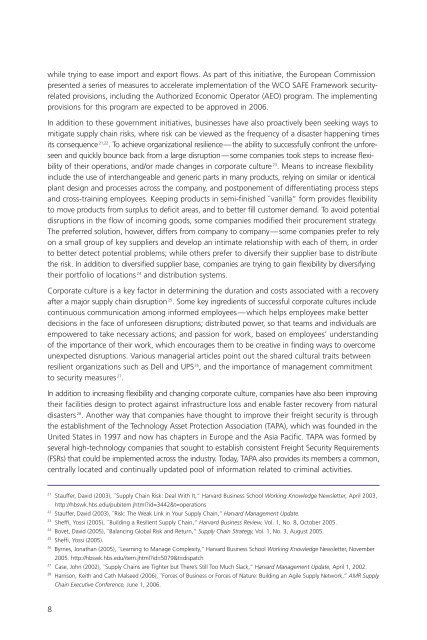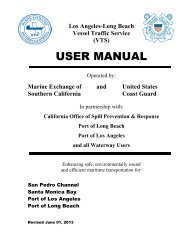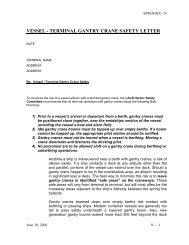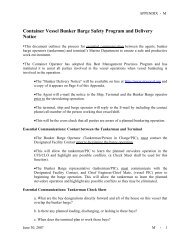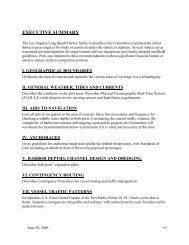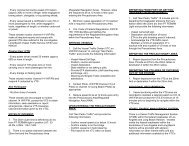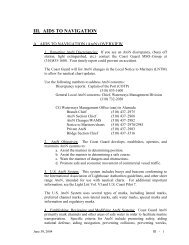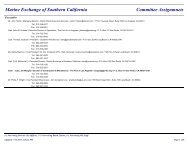Innovators in Supply Chain Security: - IBM
Innovators in Supply Chain Security: - IBM
Innovators in Supply Chain Security: - IBM
Create successful ePaper yourself
Turn your PDF publications into a flip-book with our unique Google optimized e-Paper software.
while try<strong>in</strong>g to ease import and export flows. As part of this <strong>in</strong>itiative, the European Commission<br />
presented a series of measures to accelerate implementation of the WCO SAFE Framework securityrelated<br />
provisions, <strong>in</strong>clud<strong>in</strong>g the Authorized Economic Operator (AEO) program. The implement<strong>in</strong>g<br />
provisions for this program are expected to be approved <strong>in</strong> 2006.<br />
In addition to these government <strong>in</strong>itiatives, bus<strong>in</strong>esses have also proactively been seek<strong>in</strong>g ways to<br />
mitigate supply cha<strong>in</strong> risks, where risk can be viewed as the frequency of a disaster happen<strong>in</strong>g times<br />
its consequence 21,22 . To achieve organizational resilience—the ability to successfully confront the unforeseen<br />
and quickly bounce back from a large disruption—some companies took steps to <strong>in</strong>crease flexibility<br />
of their operations, and/or made changes <strong>in</strong> corporate culture 23 . Means to <strong>in</strong>crease flexibility<br />
<strong>in</strong>clude the use of <strong>in</strong>terchangeable and generic parts <strong>in</strong> many products, rely<strong>in</strong>g on similar or identical<br />
plant design and processes across the company, and postponement of differentiat<strong>in</strong>g process steps<br />
and cross-tra<strong>in</strong><strong>in</strong>g employees. Keep<strong>in</strong>g products <strong>in</strong> semi-f<strong>in</strong>ished ``vanilla” form provides flexibility<br />
to move products from surplus to deficit areas, and to better fill customer demand. To avoid potential<br />
disruptions <strong>in</strong> the flow of <strong>in</strong>com<strong>in</strong>g goods, some companies modified their procurement strategy.<br />
The preferred solution, however, differs from company to company—some companies prefer to rely<br />
on a small group of key suppliers and develop an <strong>in</strong>timate relationship with each of them, <strong>in</strong> order<br />
to better detect potential problems; while others prefer to diversify their supplier base to distribute<br />
the risk. In addition to diversified supplier base, companies are try<strong>in</strong>g to ga<strong>in</strong> flexibility by diversify<strong>in</strong>g<br />
their portfolio of locations 24 and distribution systems.<br />
Corporate culture is a key factor <strong>in</strong> determ<strong>in</strong><strong>in</strong>g the duration and costs associated with a recovery<br />
after a major supply cha<strong>in</strong> disruption 25 . Some key <strong>in</strong>gredients of successful corporate cultures <strong>in</strong>clude<br />
cont<strong>in</strong>uous communication among <strong>in</strong>formed employees—which helps employees make better<br />
decisions <strong>in</strong> the face of unforeseen disruptions; distributed power, so that teams and <strong>in</strong>dividuals are<br />
empowered to take necessary actions; and passion for work, based on employees’ understand<strong>in</strong>g<br />
of the importance of their work, which encourages them to be creative <strong>in</strong> f<strong>in</strong>d<strong>in</strong>g ways to overcome<br />
unexpected disruptions. Various managerial articles po<strong>in</strong>t out the shared cultural traits between<br />
resilient organizations such as Dell and UPS 26 , and the importance of management commitment<br />
to security measures 27 .<br />
In addition to <strong>in</strong>creas<strong>in</strong>g flexibility and chang<strong>in</strong>g corporate culture, companies have also been improv<strong>in</strong>g<br />
their facilities design to protect aga<strong>in</strong>st <strong>in</strong>frastructure loss and enable faster recovery from natural<br />
disasters 28 . Another way that companies have thought to improve their freight security is through<br />
the establishment of the Technology Asset Protection Association (TAPA), which was founded <strong>in</strong> the<br />
United States <strong>in</strong> 1997 and now has chapters <strong>in</strong> Europe and the Asia Pacific. TAPA was formed by<br />
several high-technology companies that sought to establish consistent Freight <strong>Security</strong> Requirements<br />
(FSRs) that could be implemented across the <strong>in</strong>dustry. Today, TAPA also provides its members a common,<br />
centrally located and cont<strong>in</strong>ually updated pool of <strong>in</strong>formation related to crim<strong>in</strong>al activities.<br />
21<br />
Stauffer, David (2003), ``<strong>Supply</strong> Cha<strong>in</strong> Risk: Deal With It,” Harvard Bus<strong>in</strong>ess School Work<strong>in</strong>g Knowledge Newsletter, April 2003,<br />
http://hbswk.hbs.edu/pubitem.jhtml?id=3442&t=operations<br />
22<br />
Stauffer, David (2003), ``Risk: The Weak L<strong>in</strong>k <strong>in</strong> Your <strong>Supply</strong> Cha<strong>in</strong>,” Harvard Management Update.<br />
23<br />
Sheffi, Yossi (2005), ``Build<strong>in</strong>g a Resilient <strong>Supply</strong> Cha<strong>in</strong>,” Harvard Bus<strong>in</strong>ess Review, Vol. 1, No. 8, October 2005.<br />
24<br />
Bovet, David (2005), ``Balanc<strong>in</strong>g Global Risk and Return,” <strong>Supply</strong> Cha<strong>in</strong> Strategy, Vol. 1, No. 3, August 2005.<br />
25<br />
Sheffi, Yossi (2005).<br />
26<br />
Byrnes, Jonathan (2005), ``Learn<strong>in</strong>g to Manage Complexity,” Harvard Bus<strong>in</strong>ess School Work<strong>in</strong>g Knowledge Newsletter, November<br />
2005. http://hbswk.hbs.edu/item.jhtml?id=5079&t=dispatch<br />
27<br />
Case, John (2002), ``<strong>Supply</strong> Cha<strong>in</strong>s are Tighter but There’s Still Too Much Slack,” Harvard Management Update, April 1, 2002.<br />
28<br />
Harrison, Keith and Cath Malseed (2006), ``Forces of Bus<strong>in</strong>ess or Forces of Nature: Build<strong>in</strong>g an Agile <strong>Supply</strong> Network,” AMR <strong>Supply</strong><br />
Cha<strong>in</strong> Executive Conference, June 1, 2006.<br />
8


